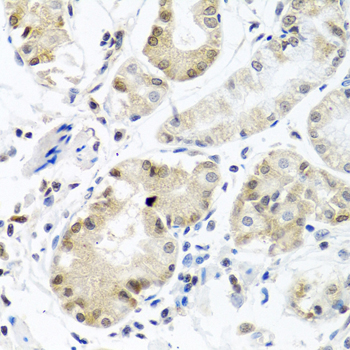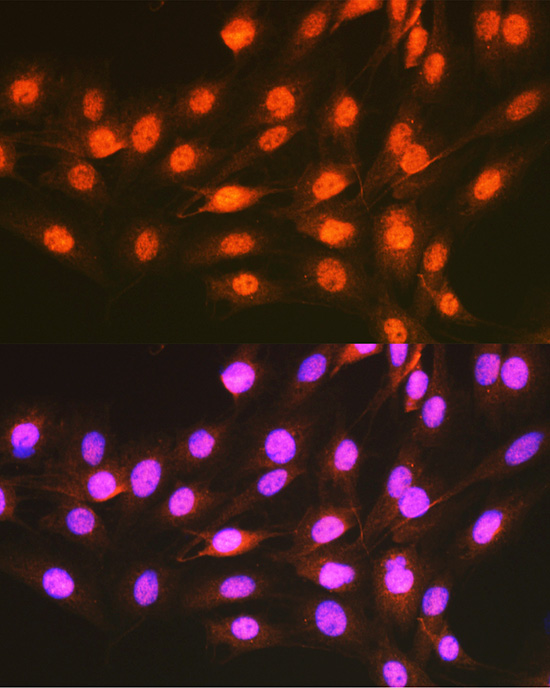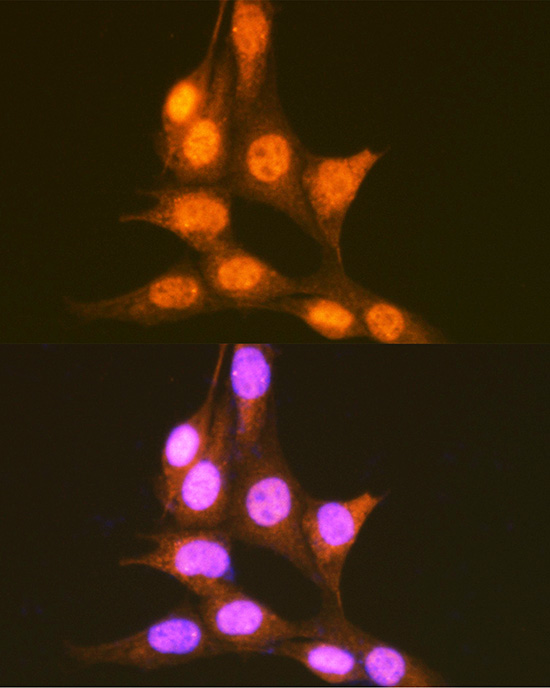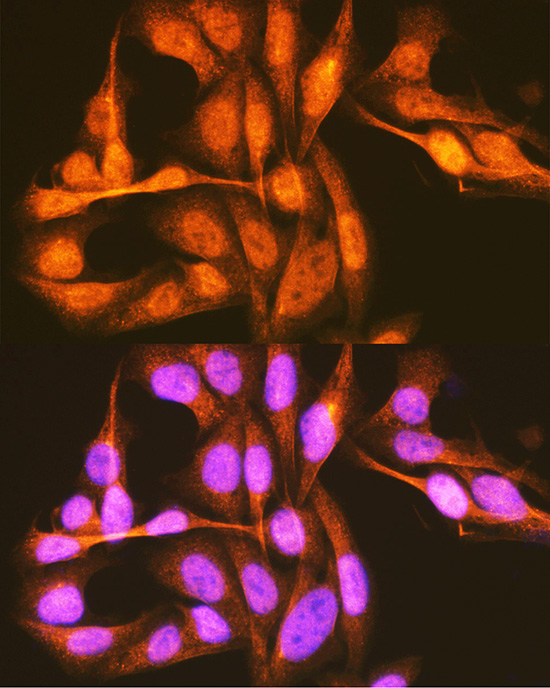Epigenetics & Nuclear Signaling Antibodies 1
Anti-PCBP1 Antibody (CAB1044)
- SKU:
- CAB1044
- Product Type:
- Antibody
- Reactivity:
- Human
- Reactivity:
- Mouse
- Reactivity:
- Rat
- Host Species:
- Rabbit
- Isotype:
- IgG
- Antibody Type:
- Polyclonal Antibody
- Research Area:
- Epigenetics and Nuclear Signaling
Description
| Antibody Name: | Anti-PCBP1 Antibody |
| Antibody SKU: | CAB1044 |
| Antibody Size: | 20uL, 50uL, 100uL |
| Application: | WB IHC IF |
| Reactivity: | Human, Mouse, Rat |
| Host Species: | Rabbit |
| Immunogen: | A synthetic peptide corresponding to a sequence within amino acids 100-200 of human PCBP1 (NP_006187.2). |
| Application: | WB IHC IF |
| Recommended Dilution: | WB 1:500 - 1:2000 IHC 1:50 - 1:100 IF 1:50 - 1:200 |
| Reactivity: | Human, Mouse, Rat |
| Positive Samples: | NIH/3T3, HepG2, MCF7, Mouse liver, Rat liver |
| Immunogen: | A synthetic peptide corresponding to a sequence within amino acids 100-200 of human PCBP1 (NP_006187.2). |
| Purification Method: | Affinity purification |
| Storage Buffer: | Store at -20'C. Avoid freeze / thaw cycles. Buffer: PBS with 0.02% sodium azide, 50% glycerol, pH7.3. |
| Isotype: | IgG |
| Sequence: | LRLV VPAT QCGS LIGK GGCK IKEI REST GAQV QVAG DMLP NSTE RAIT IAGV PQSV TECV KQIC LVML ETLS QSPQ GRVM TIPY QPMP ASSP VICA GGQD R |
| Gene ID: | 5093 |
| Uniprot: | Q15365 |
| Cellular Location: | Cytoplasm, Nucleus |
| Calculated MW: | 37kDa |
| Observed MW: | 37kDa |
| Synonyms: | PCBP1, HEL-S-85, HNRPE1, HNRPX, hnRNP-E1, hnRNP-X |
| Background: | This intronless gene is thought to have been generated by retrotransposition of a fully processed PCBP-2 mRNA. This gene and PCBP-2 have paralogues (PCBP3 and PCBP4) which are thought to have arisen as a result of duplication events of entire genes. The protein encoded by this gene appears to be multifunctional. It along with PCBP-2 and hnRNPK corresponds to the major cellular poly(rC)-binding protein. It contains three K-homologous (KH) domains which may be involved in RNA binding. This encoded protein together with PCBP-2 also functions as translational coactivators of poliovirus RNA via a sequence-specific interaction with stem-loop IV of the IRES and promote poliovirus RNA replication by binding to its 5'-terminal cloverleaf structure. It has also been implicated in translational control of the 15-lipoxygenase mRNA, human Papillomavirus type 16 L2 mRNA, and hepatitis A virus RNA. The encoded protein is also suggested to play a part in formation of a sequence-specific alpha-globin mRNP complex which is associated with alpha-globin mRNA stability. |
| UniProt Protein Function: | hnRNP E1: Single-stranded nucleic acid binding protein that binds preferentially to oligo dC. Abundantly expressed in skeletal muscle, thymus and peripheral blood leukocytes while a lower expression is observed in prostate, spleen, testis, ovary, small intestine, heart, liver, adrenal and thyroid glands. |
| UniProt Protein Details: | Protein type:Translation; RNA splicing; RNA-binding Chromosomal Location of Human Ortholog: 2p13-p12 Cellular Component: cytoplasm; intracellular membrane-bound organelle; membrane; nucleoplasm Molecular Function:mRNA binding; protein binding; RNA binding; single-stranded DNA binding Biological Process: gene expression; nuclear mRNA splicing, via spliceosome |
| NCBI Summary: | This intronless gene is thought to have been generated by retrotransposition of a fully processed PCBP-2 mRNA. This gene and PCBP-2 have paralogues (PCBP3 and PCBP4) which are thought to have arisen as a result of duplication events of entire genes. The protein encoded by this gene appears to be multifunctional. It along with PCBP-2 and hnRNPK corresponds to the major cellular poly(rC)-binding protein. It contains three K-homologous (KH) domains which may be involved in RNA binding. This encoded protein together with PCBP-2 also functions as translational coactivators of poliovirus RNA via a sequence-specific interaction with stem-loop IV of the IRES and promote poliovirus RNA replication by binding to its 5'-terminal cloverleaf structure. It has also been implicated in translational control of the 15-lipoxygenase mRNA, human Papillomavirus type 16 L2 mRNA, and hepatitis A virus RNA. The encoded protein is also suggested to play a part in formation of a sequence-specific alpha-globin mRNP complex which is associated with alpha-globin mRNA stability. [provided by RefSeq, Jul 2008] |
| UniProt Code: | Q15365 |
| NCBI GenInfo Identifier: | 42560548 |
| NCBI Gene ID: | 5093 |
| NCBI Accession: | Q15365.2 |
| UniProt Secondary Accession: | Q15365,Q13157, Q14975, |
| UniProt Related Accession: | Q15365 |
| Molecular Weight: | 37,498 Da |
| NCBI Full Name: | Poly(rC)-binding protein 1 |
| NCBI Synonym Full Names: | poly(rC) binding protein 1 |
| NCBI Official Symbol: | PCBP1 |
| NCBI Official Synonym Symbols: | HNRPX; HNRPE1; hnRNP-X; HEL-S-85; hnRNP-E1 |
| NCBI Protein Information: | poly(rC)-binding protein 1 |
| UniProt Protein Name: | Poly(rC)-binding protein 1 |
| UniProt Synonym Protein Names: | Alpha-CP1; Heterogeneous nuclear ribonucleoprotein E1; hnRNP E1; Nucleic acid-binding protein SUB2.3 |
| Protein Family: | Poly(rC)-binding protein |
| UniProt Gene Name: | PCBP1 |
| UniProt Entry Name: | PCBP1_HUMAN |
View AllClose








![PCBP1 Monoclonal Antibody [PAT2A10AT] (CPAB0595) PCBP1 Monoclonal Antibody [PAT2A10AT] (CPAB0595)](https://cdn11.bigcommerce.com/s-rd6ounxcu2/images/stencil/590x590/products/58815/63997/assay-genie-box-4__27595.1706535226.jpg?c=1)


